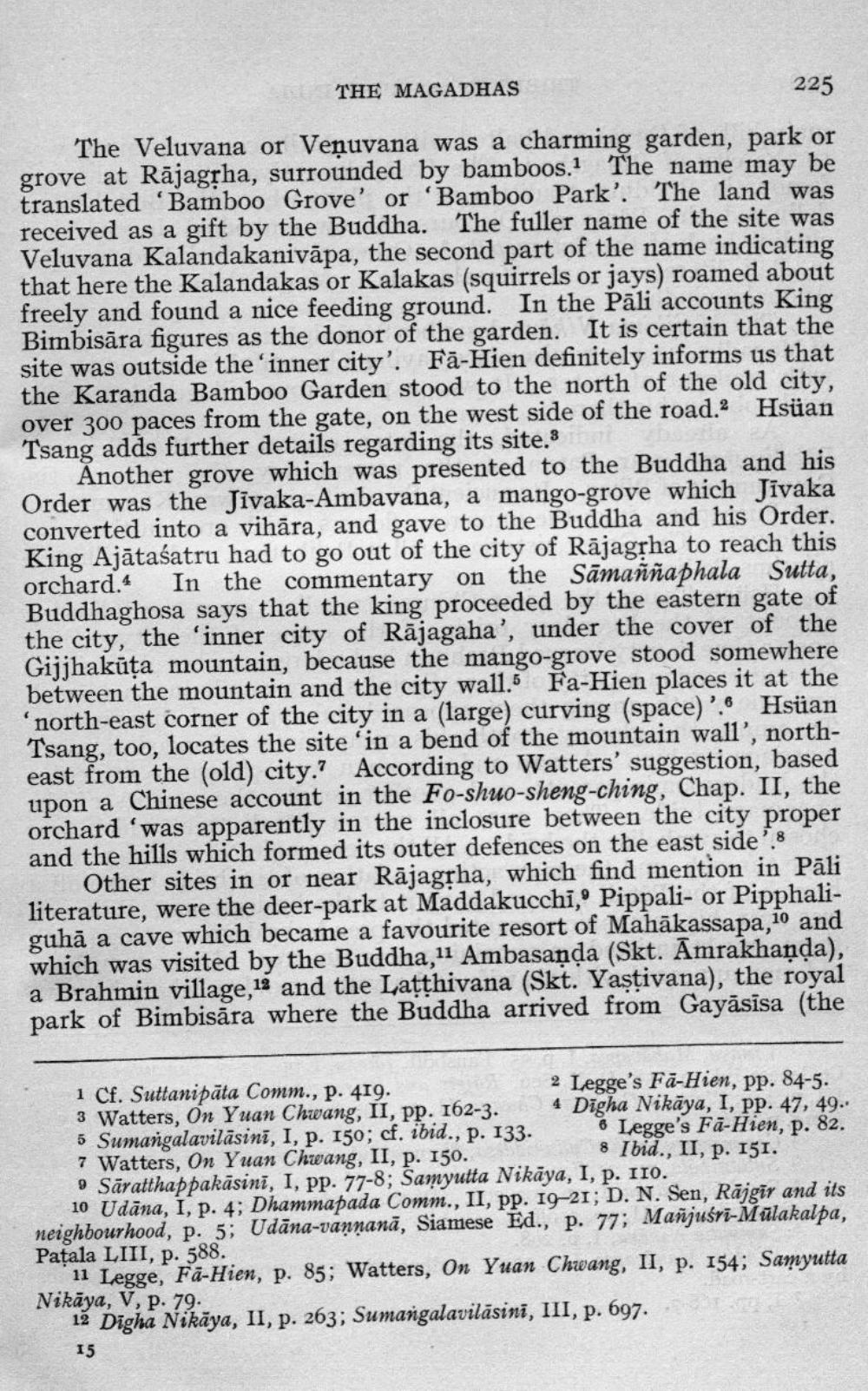________________
THE MAGADHAS
225
The Veluvana or Veņuvana was a charming garden, park or grove at Rājagrha, surrounded by bamboos.1 The name may be translated 'Bamboo Grove' or 'Bamboo Park'. The land was received as a gift by the Buddha. The fuller name of the site was Veluvana Kalandakanivāpa, the second part of the name indicating that here the Kalandakas or Kalakas (squirrels or jays) roamed about freely and found a nice feeding ground. In the Pāli accounts King Bimbisāra figures as the donor of the garden. It is certain that the site was outside the inner city'. Fā-Hien definitely informs us that the Karanda Bamboo Garden stood to the north of the old city, over 300 paces from the gate, on the west side of the road.2 Hsüan Tsang adds further details regarding its site.3
Another grove which was presented to the Buddha and his Order was the Jivaka-Ambavana, a mango-grove which Jivaka converted into a vihāra, and gave to the Buddha and his Order. King Ajātaśatru had to go out of the city of Rājagrha to reach this orchard. In the commentary on the Sāmaññaphala Sutta, Buddhaghosa says that the king proceeded by the eastern gate of the city, the ‘inner city of Rājagaha', under the cover of the Gijjhakūta mountain, because the mango-grove stood somewhere between the mountain and the city wall. Fa-Hien places it at the 'north-east corner of the city in a (large) curving (space)'.6 Hsüan Tsang, too, locates the site 'in a bend of the mountain wall', northeast from the (old) city.? According to Watters' suggestion, based upon a Chinese account in the Fo-shuo-sheng-ching, Chap. II, the orchard 'was apparently in the inclosure between the city proper and the hills which formed its outer defences on the east side'.8
Other sites in or near Rājagrha, which find mention in Pāli literature, were the deer-park at Maddakucchi, Pippali- or Pipphaliguhā a cave which became a favourite resort of Mahākassapa,10 and which was visited by the Buddha, 11 Ambasaņda (Skt. Amrakhanda), a Brahmin village, 12 and the Latthivana (Skt. Yaștivana), the royal park of Bimbisāra where the Buddha arrived from Gayāsīsa (the
1 Cf. Suttani pāta Comm., p. 419.
2 Legge's Fā-Hien, pp. 84-5. 3 Watters, On Yuan Chwang, II, pp. 162-3. 4 Dīgha Nikāya, I, pp. 47, 49. 5 Sumangalavilāsini, I, p. 150; cf. ibid., p. 133. 8 Legge's Fä-Hien, p. 82. 7 Watters, On Yuan Chwang, II, p. 150.
8 Ibid., II, p. 151. • Sāratthappakāsinī, 1, pp. 77-8; Samyutta Nikāya, I, p. 110.
10 Udāna, I, p. 4; Dhammapada Comm., II, pp. 19-21; D. N. Sen, Rājgir and its neighbourhood, p. 5; Udāna-vannanā, Siamese Ed., p. 77; Mañjuśyi-Mülakalpa, Patala LIII, p. 588.
11 Legge, Fä-Hien, p. 85; Watters, On Yuan Chwang, II, p. 154; Samyutta Nikaya, V, P. 79.
iz Digha Nikāya, II, p. 263; Sumangalavilāsini, III, p. 697.
15




